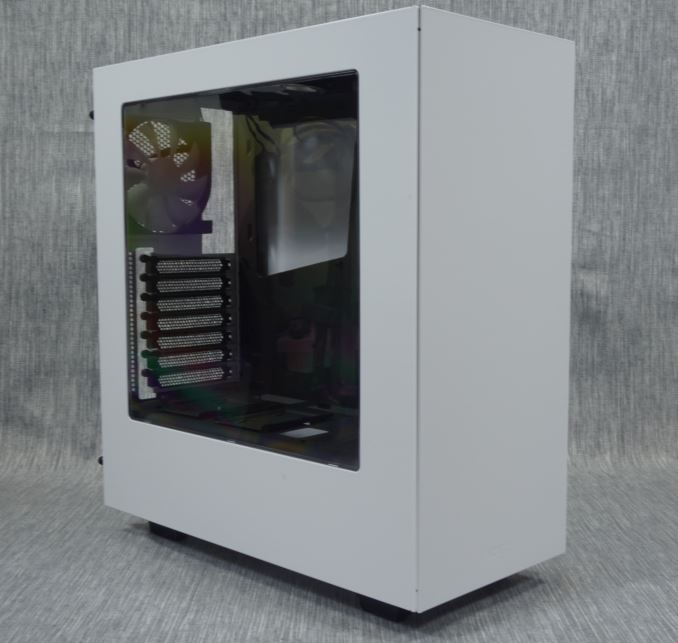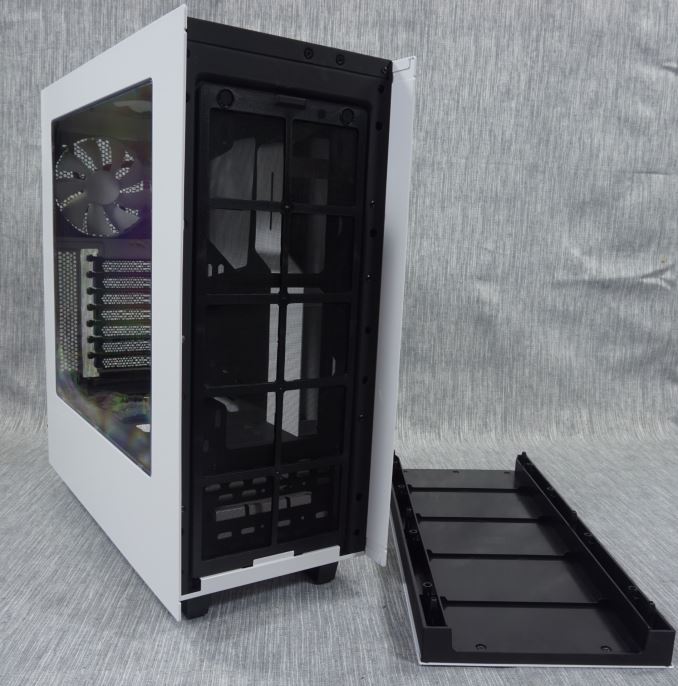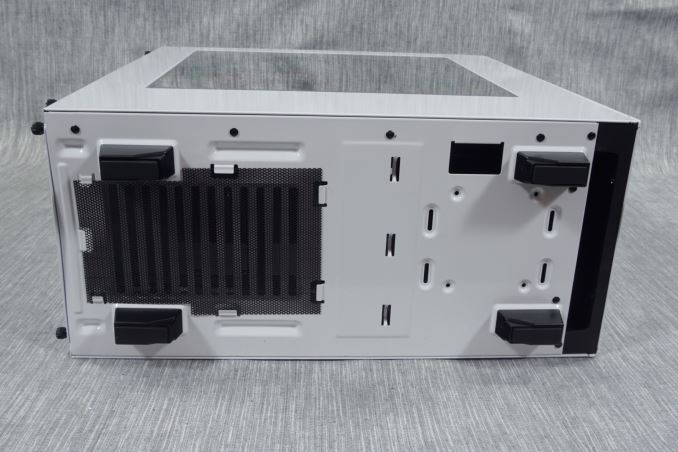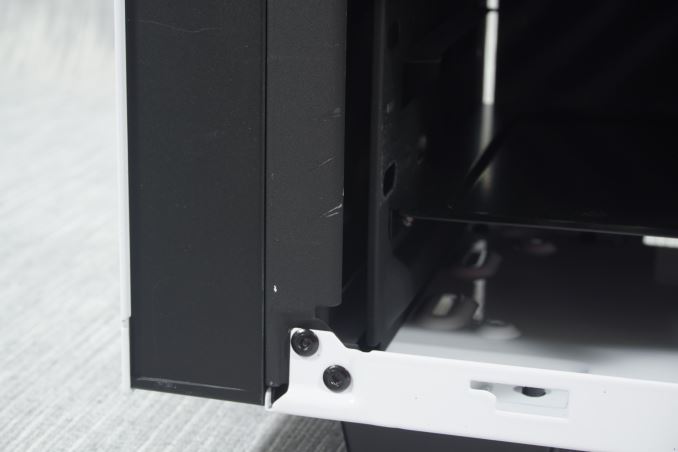The NZXT S340 Case Review
by E. Fylladitakis on July 13, 2015 8:00 AM EST- Posted in
- Cases/Cooling/PSUs
- NZXT
- Case
- ODD-Free
The Exterior of the NZXT S340
In terms of design, the S340 is just about as minimalistic as it gets. It literally is just a rectangular metallic box, with an entirely flat faceplate and side panels. Even the company logo that is embossed near the bottom of the faceplate is difficult to discern. We received the white version of the S340, which has a glossy exterior with matte black accents and a black interior. The left side panel of our sample is partially windowed, revealing the entire system compartment but leaving out the area where the PSU and the 3.5” drives are.
As we anticipated, the metallic faceplate is just a sheet of metal attached on a thick plastic frame. This is natural for both practical reasons and considering the price of the case. The flexibility of plastic allows for panels that can be easily attached to and removed from the metallic frame of the case, whereas a metallic construct would be heavy and it would definitely require some sort of locking mechanism or screws to stay in place. A very large nylon air filter covers the entire front of the case behind the front panel. As we mentioned in the introduction, there is not a single 5.25” device bay.
One of NZXT's primary marketing points regarding the S340 is its compact size. True enough, the S340 is very small for a tower case, with a volume of just 0.0384 cubic meters. This makes it even smaller than the Corsair Obsidian 350D (0.0416m3, 8% greater volume), a case that is limited up to micro ATX motherboards. It also is much smaller than the SilverStone Fortress FT05 (0.0456m3, 17.15% greater volume), which also is an "ODD-Free" design. The extensive use of steel makes the S340 a relatively slightly heavy case for its size, tipping the scales at 7 kg while completely empty.
Even though the interior of the case is black, the rear and bottom of the frame are sprayed with the same glossy white color as the faceplate and side panels. The PSU compartment is at the bottom of the case, where four thumbscrews are holding a cover in place. As we will see later, the PSU can only be installed by taking off this cover and inserting a PSU from the back of the case. A very basic metallic mesh filter can be found at the bottom of the case, covering the opening of the PSU intake. It also is noteworthy that the S340 has slightly tall feet for a case of this design and size.
The top of the S340 is matte black with all versions of the case, including the white version that we received for this review. The power on button, two USB 3.0 ports and the two headphone jacks can be found at the right front edge of the top panel. A LED ring surrounds the power on button, serving as the power on indicator.
The matte black color of the top and the interior of the case is very smooth and has an excellent feel to the touch. However, it also is very easy to scratch. This will be particularly obvious on the front frame, where the latches of the side panels lock. The matte paint at the sides of the front frame was already scratched when we removed them for the first time. One should be very, very careful when working with the S340, especially around its interior.

















48 Comments
View All Comments
HQQKrWithAPC - Wednesday, July 15, 2015 - link
with the smaller cases and mini boards, you will have problems with keeping her cool, in general - smaller the case - the hotter it runs. Full towers - are the standard for "balls to the wall" gamers, and for good reason....more space...more air - and cooler temps.romrunning - Wednesday, July 15, 2015 - link
@HQQKrWithAPCI'll disagree with the generalization that full towers = cooler temps.
If a case is designed with good *air flow*, then it will do well with cooling. A poorly designed case, even a full tower, will have problems no matter what internal volume it might have.
Impulses - Monday, July 13, 2015 - link
The biggest issue is case makers are always trying to cater the largest possible market and they end up straddling weird lines...This NZXT design would indeed work better for a M-ATX or ultra quiet build. I doubt anyone that's gonna use SLI/CF (much less water cooling) is gonna be very interested in this, so why bother catering to those markets.
I'm a CF, sound card, and ODD user myself, and I still struggle to find cases that meet my needs perfectly. I have little need for half a dozen 3.5" bays but all enthusiast cases seem built to house a server array of discs...
My Corasair Air 540 is working alright for now, specially for the price I paid, tho I still feel it wastes too much space on the right hand compartment.
Dorek - Wednesday, July 29, 2015 - link
"Do we really need a 36cm deep case to fit a 240mm radiator?"Yes, next question.
"I suppose the same question can be asked of why not a Mini ITX motherboard though; it's rare to see anyone actually needing more than one PCIe slot, as IMO it's usually better to just get a single card and upgrade it later, as multi-card setups are almost always disappointing."
Wrong.
"I do wish we'd get away from the longer cards actually, as there are too few good half-length offerings, though the 960 from Nvidia and the new Nano from AMD seem like good options."
Those are for small-form-factor builds only. If you want an SFF build, build one. This is an ATX case and isn't meant for that.
Samus - Monday, July 13, 2015 - link
I think the irony is the case is 36cm deep (long) yet the expansion slot design leaves that huge gap around the screws. This will invite bugs and rodents to live in the case. My rule of thumb is no openings greater than 1/4" in a PC case and that gap is nearly 3/4" all around. You might as well just leave all the expansion slot covers off!Considering the already lengthy depth, they could have just added 1/2" (a few centimeters) too the overall length, recessing the I/O plates, but the stamping was probably too expensive for the budget compared to using a "flat" back where the expansion slot "gap" was actually created by stamping out the lip. Definitely an economical solution, but at least include a cover?
Flunk - Monday, July 13, 2015 - link
I think that might be a location specific issue, with rodents and insects. I've never had problems like that.Samus - Monday, July 13, 2015 - link
When I used to service PC's in Chicago, I came across this a lot. Fortunately I never had to deal with a live infestation, usually just droppings. But I'd say it was more common in the 90's and early 00's than these days where custom built PC's are virtually non-existent outside of the enthusiast. But even still, someone often leaves a dust cover off and something gets in and takes a piss all over the back of the videocard.PC's offer a warm, dark, secluded space, very attractive to pests.
Impulses - Monday, July 13, 2015 - link
Can't say I've ever seen that after 10+ years of small business IT work in Puerto Rico (and a lot of places I've worked don't even have central AC etc)... I have seen a handful of old systems literally choke and overheat on dust sucked in from every pore tho.ES_Revenge - Monday, July 13, 2015 - link
Where were these people keeping their PCs? Outside? Or are they living in filth? LOL. The only thing I can think of possibly entering a computer case in my house is a spider, but even then I've never come across more than cobwebs in a PC case before.Dorek - Wednesday, July 29, 2015 - link
I've literally never had a bug enter any electronic device that I have owned in my entire life. Are you keeping your computer outdoors? Do you never clean your house?